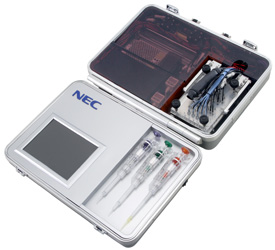NEC Develops world''s first fully integrated portable DNA analyser
15 Oct 2007
 Japan''s
NEC Corporation, has developed the world''s first portable human DNA analyser with
another Japanese technology firm the Sagami-based Aida Engineering. This analyser
integrates all steps of the DNA analysis process, from DNA extraction to electrophoresis
and individual profiling.
Japan''s
NEC Corporation, has developed the world''s first portable human DNA analyser with
another Japanese technology firm the Sagami-based Aida Engineering. This analyser
integrates all steps of the DNA analysis process, from DNA extraction to electrophoresis
and individual profiling.Interestingly, NEC Corporation is one of the world''s leading providers of internet, broadband network and enterprise business solutions dedicated to meeting the specialized needs of its diverse and global base of customers.
The analyser has been developed mainly for the law enforcement market to aid in criminal investigation. By narrowing the analyser''s application to DNA analysis specifically for individual identification, developers have streamlined the analytical process and realised a compact device the size of an attaché case (500mm W x 400mm D x 200mm H) that can be easily transported and analysed at the scene of crimes.
DNA analysis process consists of five steps: (1) cell collection, (2) DNA extraction, (3) Polymerase Chain Reaction (PCR) to amplify DNA fragments, (4) electrophoresis to ascertain DNA "fingerprints" and (5) STR analysis for determining genetic profiling. NEC''s newly developed device is the world''s first portable DNA analyser to fully integrate the entire process.
The compact nature of the analyser facilitates coordination between each step and greatly expedites the PCR procedure where DNA fragments are alternatively heated and cooled. As a result, the device can complete the entire process, from DNA extraction to analysis, in approximately 25 minutes.
NEC is confident that the analyser will speed up criminal investigations and aid crime prevention efforts. The company will continue to make further improvements to the device and strengthen development activities in readiness for full-scale production in 2008.
Highlights of NEC''s DNA analyser for individual profiling:
1.
Compact for improved portability
The use of miniaturised versions of PCR and
electrophoresis equipment incorporating "lab-on-a-chip" technology,
an innovation that replaces test tubes with a plastic chip, has resulted in the
entire device being more compact.
The use of "lab-on-a-chip" technology has emerged from the development of dedicated chips that feature multiple layers of silicon film laminated on a single layer of resin. Conventional PCR and electrophoresis equipment is typically the size of a small printer and compact refrigerator, respectively. In this new device, however, this equipment has been greatly miniaturized to approximately 10cm x 5cm x 5cm and 10cm x 5cm x 3cm.
2.
High speed analysis in approximately 25 minutes
The compact nature of the analyser
facilitates coordination between each step in DNA analysis, resulting in faster
processing. The speed of the new compact analyser over larger devices is particularly
evident during the PCR step.
Traditionally, DNA analysis required approximately one working day (one week when re-testing was required) and numerous devices to complete all necessary procedures. It was therefore difficult to make a quick shortlist of suspects using DNA analysis soon after a crime had occurred.
This situation led to calls being made for a device that would provide quick DNA analysis at the scene of a crime. At the same time, the CODIS (Combined DNA Index System: presently holds data on approximately 4 million individuals) database for storing DNA data on crime suspects and other individuals was under development in the U.S. and is presently utilized in criminal investigations. This trend towards data sharing has spread across the globe, with Japan also working to install a similar DNA database.
DNA
analysis process
(1) Cell Collection
The cell collection is integral
to DNA analysis. It is possible to collect cells from blood samples and/or oral
swab (simple oral swab using a cotton bud).
(2)
DNA extraction
DNA is extracted from collected cells using special reagents.
(3) PCR (polymerase
chain reaction) amplification
The technique known as PCR* is used to amplify
specific fragments of DNA to a number of copies that makes analysis possible.
*DNA
fragments are alternatively heated and cooled at fixed temperature intervals with
special reagents.
(4)
Electrophoresis
Amplified DNA fragments are injected into a polymer gel. A
high voltage is applied to the gel to move DNA molecules towards the anode. (This
is because the DNA itself takes on a negative charge.) As the polymer is uniformly
porous, DNA molecules meet resistance and travel through this matrix at different
rates depending on the fragment size of each molecule. (The polymer forms a molecular
sieve where smaller molecules move faster than larger molecules.) The principle
of electrophoresis is used to measure the size of DNA fragment.
(5)
STR (short tandem repeat) analysis
The human genome has a number of unique
genetic elements. These elements are formed when a DNA sequence, consisting of
4-5 of the nucleic acids that make up DNA (A/C/G/T), are repeated as a pattern.
The number of repeated sequences may differ from person to person and it is the
analysis of this repetition that enables genetic profiling.
Lab-on-a-chip
Technology
Lab-on-a-chip technology features wells and channels on a small
plastic base chip, where each well is used as an individual "test tube".
With a diameter of around 5mm these
well are much smaller than regular test tubes. The transfer of fluid across the
wells is facilitated by the channels. This allows lab processes to be scaled down
to a chip format without the need for regular fluid transfer tools (such as pipettes).













.jpg)






.jpg)









